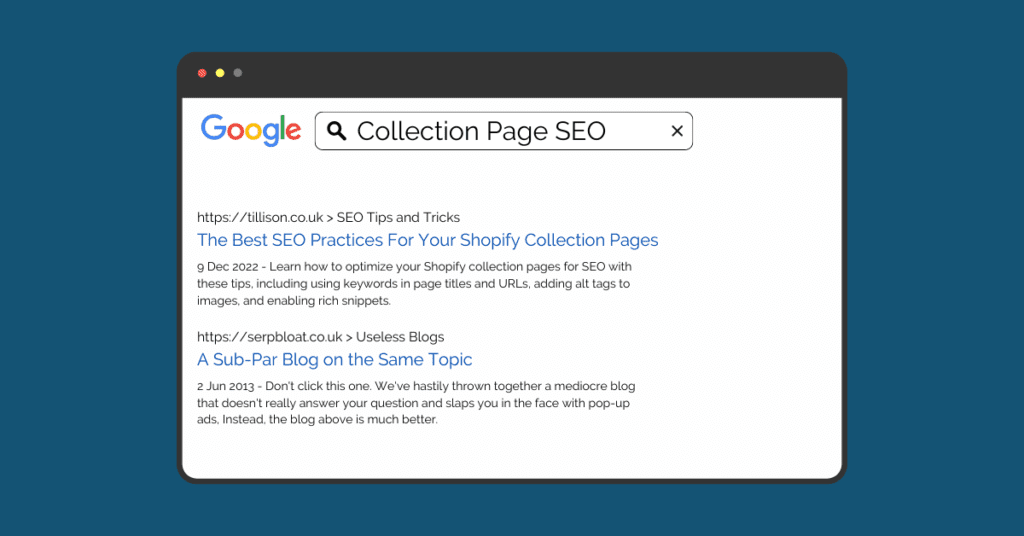This post is part of The Ultimate Guide to Shopify SEO. Also in this series:
- How to setup Google Search Console for Shopify
- How to Update robots.txt in Shopify
- How to Add a Meta Title and Description in Shopify
- Quick guide: How to Create Redirects in Shopify
- 5 Ways to Improve Shopify Image Optimisation for SEO
- The Best SEO Practices for Shopify Collection Pages
- 7 Great Shopify Product Page Tips
Ok, you’ve created some collection pages. You’ve got them looking fancy, and you’ve listed all of your products. But, nobody is coming to your site.
Why?
Well, having a beautiful site is one thing, but if search engines can’t discover it and it hasn’t been optimized for SEO, it’s ultimately pointless. Nobody wants to be in this situation so we’ve put together a list of our quick tips to uplift your Shopify collection page SEO today!
1. Use keywords in your collection page titles and URLs
This is quite a simple one but it’s still something that can be overlooked by website owners. Carefully targeting the best keywords for your pages is [eCommerce SEO](/ecommerce-seo-agency/) 101, but failing to do so can be seriously harmful to the search visibility of your pages.
Include keywords in your collection page titles and URLs that accurately describe the products on the page. To narrow it down, consider targeting commercial intent keywords with lower competition (the ‘low-hanging fruit’). If your budget allows, you could even target the high volume, but high competition, terms and reap the rewards!
Doing this will help search engines understand what the page is about and index it properly. For example, if your collection page features beach towels, your page title could be “Beach Towels – Summer Collection” and your URL could be “yourstore.com/collections/beach-towels”.
2. Use descriptive and keyword-rich descriptions
Similar to our previous tip, having a good amount of relevant supporting keywords is crucial to indicate to your search engines what your content is about – increasing your discoverability.
A great idea is to assess the content and keyword of your competitors. This will allow you to identify the gaps in the valuable keywords to include and, similarly, see if they have a greater content depth than you. Content depth is a ranking factor and definitely should be considered!
In terms of keyword-rich copy, if you were, for example, selling beach towels, your product title could be “Soft and Absorbent Beach Towels – Perfect for the Summer” and your product description could be “These beach towels are made of soft and absorbent material that’s perfect for soaking up the sun at the beach. They’re available in a variety of colors and sizes to suit your needs.”
3. Use alt tags for product images
Alt tags, also known as alt text, are attributes that describe the content of an image. Including keywords in your alt tags can help search engines understand what the image is and index it properly. Not only does it help search engines, but they also help describe images for users who rely on assistive tools to browse the internet such as text-to-speech (TTS) or screen readers.
As such, including these is critical to ensure that your products are as accessible as possible for your audience.
For example, if your product image is of a beach towel, your alt tag could be “beach towel on a sandy beach”. We would advise consulting [official guidelines](https://developers.google.com/search/docs/appearance/google-images) for writing these to ensure that they are done properly.
4. Use headings and subheadings on your collection pages
Headings and subheadings help organize your content and make it easier for readers to scan and understand. They also help search engines understand the structure of your page and its content.
Use heading tags (H1, H2, etc.) to indicate the hierarchy of your content, and include keywords in your headings and subheadings where appropriate.
5. Create a sitemap for your collection pages
A sitemap is a file that lists all the pages on your website and helps search engines index them properly. To create a sitemap for your collection pages, go to the “Online Store” section of your Shopify admin and click on “Sitemap”. From there, you can add your collection pages to your sitemap and submit them to search engines.
We’ve covered what sitemaps are and how to generate them in another blog [here](/blog/5-great-wordpress-xml-sitemap-generators-to-use/).
6. Use rich snippets to display your products in search results
Rich snippets are additional pieces of information that appear in search results, such as product ratings and prices. Enabling rich snippets for your collection pages can help your products stand out in search results and attract more clicks.
To enable rich snippets for your collection pages, go to the “Online Store” section of your Shopify admin and click on “Preferences”. From there, you can enable rich snippets and specify the information that you want to display.
In conclusion, optimizing your Shopify collection pages for SEO can help improve your visibility on search engines and drive more traffic to your online store. By using keywords in your page titles and URLs, product titles and descriptions, and alt tags, and by creating a sitemap and using rich snippets, you can help search engines understand and index your collection pages properly. This, in turn, can help attract more traffic and potential customers to your store.
Optimizing Shopify collection pages for SEO can be a little tricky. So, if you’re not SEO savvy and need advice or if you would like it to be meticulously handled for you, it’s always a good idea to consult an expert [SEO Agency](/seo-management-services/), or more specifically a [Shopify SEO agency](/ecommerce-seo-agency/shopify-seo/) or an [eCommerce SEO agency](/ecommerce-seo-agency/)!







